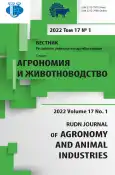Анализ молекулярных данных паразитоидных мух семейства Tachinidae
- Авторы: Арафа Э.Э.1,2
-
Учреждения:
- Российский университет дружбы народов
- Научно-исследовательский институт защиты растений, Центр сельскохозяйственных исследований
- Выпуск: Том 17, № 1 (2022)
- Страницы: 48-61
- Раздел: Защита растений
- URL: https://journal-vniispk.ru/2312-797X/article/view/315650
- DOI: https://doi.org/10.22363/2312-797X-2022-17-1-48-61
- ID: 315650
Цитировать
Полный текст
Аннотация
Паразитоиды семейства Tachinidae играют важную роль в биологическом контроле, тем не менее филогенетические взаимоотношения надродовых групп мало изучены. Здесь мы представляем филогенетический анализ семейства, основанный на молекулярных данных. Филогенетический анализ в молекулярном исследовании, включающем 73 вида, принадлежащих к 30 родам тахинид, включая четыре признанных в настоящее время подсемейства (Dexiinae, Exoristinae, Phasiinae, Tachininae) и 20 триб. Тахиниды реконструируются как монофилетический комплекс на основании морфологических данных и с четырьмя негомоплазиозными апоморфиями (синапоморфиями). Монофилия хорошо поддерживается начальной загрузкой. Наш морфологический анализ в целом поддерживает подсемейство, объединяющее Dexiinae + Phasiinae, в то время как Tachininae + Exoristinae не поддерживается как одна группа, и только Exoristinae и Phasiinae реконструируются как монофилетические сообщества. Dexiinae, которые ранее считались устоявшимся монофилетическим сообществом (за исключением нескольких исследований), реконструированы как полипарафилетические по отношению к Phasiinae. Tachininae реконструированы как парафилетический класс, в то время как монофилия Exoristinae была восстановлена, за исключением рода Admontia Brauer & Bergenstamm, который возник в подсемействе Tachininae. В отличие от молекулярного анализа все подсемейства представляют собой полипарафилетические группы, в которых они взаимодействуют друг с другом, за исключением Phasiinae, которое включает большинство своих таксонов в монофилетическую группу.
Ключевые слова
Об авторах
Элсайед Эль-Хашаш Арафа
Российский университет дружбы народов; Научно-исследовательский институт защиты растений, Центр сельскохозяйственных исследований
Автор, ответственный за переписку.
Email: Arafa.elhashash@yahoo.com
ORCID iD: 0000-0001-5210-5515
аспирант
117198, Российская Федерация, г. Москва, ул. Миклухо-Маклая, д. 8/2Список литературы
- Stireman III JO, O’Hara JE, Wood DM. Tachinidae: evolution, behavior, and ecology. Annual Review of Entomology. 2006; 51(1):525-555.
- Cerretti PO, O’Hara JE, Wood DM, Shima H, Inclan DJ, Stireman III JO. Signal through the noise? Phylogeny of the Tachinidae (Diptera) as inferred from morphological evidence. Systematic Entomology. 2014; 39(2):335-353. doi: 10.1111/syen.12062
- Stireman III JO, Cerretti P, O’Hara JE, Blaschke JD, Moulton JK. Molecular phylogeny and evolution of world Tachinidae (Diptera). Systematic Entomology. 2019; 139:106358. doi: 10.1016/j.ympev.2018.12.002
- Stireman III JO. Phylogenetic relationships of tachinid flies in subfamily Exoristinae (Tachinidae: Diptera) based on 28s dDNA and elongation factor-1α. Systematic Entomology. 2002; 27(4):409-435. doi: 10.1046/j.1365-3113.2002.00187.x
- Tachi T, Shima H. Molecular phylogeny of the subfamily Exoristinae (Diptera, Tachinidae), with discussions on the evolutionary history of female oviposition strategy. Systematic Entomology. 2010; 35(1):148-163 doi: 10.1111/j.1365-3113.2009.00497.x
- Wood DM. Tachinidae. In: McAlpine JF, Peterson BV, Shewell GE, Teskey HJ, Vockeroth JR, Wood DM. (eds.) Manual of Nearctic Diptera. Volume 2. Ottawa, Canada; 1987. p.1193-1269.
- Tschorsnig HP, Richter VA. Family Tachinidae. In: Papp L, Darvas B. (eds.) Contributions to a manual of Palaearctic Diptera (with special reference to flies of economic importance). Volume 3. Higher Brachycera. Budapest: Science Herald; 1998. p.691-827.
- Kumar S, Stecher G, Li M, Knyaz C, Tamura K. MEGA X: Molecular evolutionary genetics analysis across computing platforms. Molecular Biology and Evolution. 2018; 35(6):1547-1549. doi: 10.1093/molbev/msy096
- McAlpine JF. Phylogeny and classification of the Muscomorpha. In: McAlpine JF, Wood DM (Eds) Manual of Nearctic Diptera. Volume 3. Agriculture Canada Monograph 32; 1989. Pp. 1397-1518, 1333-1581.
- Winkler IS, Blaschke JD, Davis DJ, Stireman III JO, O’Hara JE, Cerretti P, Moulton JK. Explosive radiation or uninformative genes? Origin and early diversification of tachinid flies (Diptera: Tachinidae). Molecular Phylogenetics and Evolution. 2015; 88:38-54. doi: 10.1016/j.ympev.2015.03.021
- Shima H. Parasitic way of life in tachinid flies. Insectarium. 1989; 26:4-9, 46-51, 88-94, 120-126. (In Japanese)
- Mesnil LP. 64g. Larvaevorinae (Tachininae). In: Die Fliegen der Palaearktischen Region. 1966; 10:881-928.
- Herting B. Catalogue of Palearctic Tachinidae (Diptera). In: Stuttgarter Beiträge zur Naturkunde. Serie A (Biologie). 1984.
- O’Hara JE, Wood DM. Catalogue of the Tachinidae (Diptera) of America north of Mexico. In: Memoirs on Entomology, International Volume 18. 2004.
- Blaschke JS, Stireman III JO, O’Hara JE, Cerretti P, Moulton JK. Molecular phylogenetics and piercer evolution in the bug-killing flies (Diptera: Tachinidae: Phasiinae). Systematic Entomology. 2018; 43(1):218-238. doi: 10.1111/syen.12272
Дополнительные файлы










